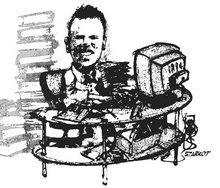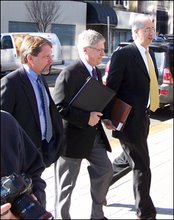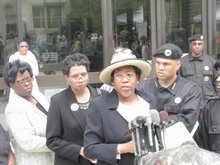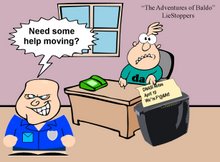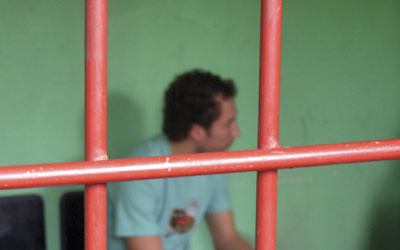Gottlieb Confesses
Sgt. Gottlieb described his testimony to the Grand Jury as follows:
I told the facts of what's documented in my report. I talked about the way Ms. Mangum presented herself at her home, what she told us, what was found at the search warrant at the residence. I explained how these people had come down to the station and given their statements. I pointed out what was again found at the search warrant. I spoke to them about the time cards issues. I talked to them about the PowerPoint presentation. And they asked me about the medical report. I told them that the SANE nurse found the information to be consistent with the story she was giving. I explained to them that there were inconsistencies in the very beginning when she was crying, upset, whatever. But as soon as Nurse Levicy was able to calm her down, which didn't take long at all, she never changed her story from that point. I hope that covers in all.Sgt. Gottlieb's description of his Grand Jury testimony is reminiscent of the bizarre explanation given by DPD Chief Steve Chalmers following his widely ridiculed "report" on the department's complicity in the Hoax. In response to Chalmer's similar attempt to suggest that the false accuser was a credible and consistent witness prior to the Grand Jury deception, we noted:
In an interview with the Herald-Sun's Ray Gronberg, the truth-challenged Chalmers asked the public to join him in the Twilight Zone by incredibly claiming:“The only information we had was the information that we had gotten from [Crystal Magnum]… and at the point we did go into the grand jury, [Mangum’s] accounts were consistent up to that point.”
In reality, the false accuser's credibility and consistency were so lacking that Attorney General Cooper took the unprecedented step of publicly declaring the three Duke defendants "innocent" victims of a "rogue prosecutor". It defies logic and sanity for Chalmers to now attempt to resurrect the Hoax in the immediate aftermath of Cooper's unambiguous statements debunking the Credible Accuser Hoax. In the question and answer session that followed Cooper's April 11 announcement and in his Summary of Conclusions, the AG spoke of why the false accuser was never credible, nor were her stories ever consistent.At the time of Chalmer's effort to spin the false accuser as credible and consistent, we also noted that his was not the first attempt to dupe the public with the Credible Accuser Hoax Within the Hoax.Based on the significant inconsistencies between the evidence and the various accounts given by the accusing witness, we believe these three individuals are innocent of these charges.We approached this case with the understanding that rape and sexual assault victims often have some inconsistencies in their accounts of a traumatic event. However, in this case, the inconsistencies were so significant and so contrary to the evidence that we have no credible evidence that an attack occurred in that house that night.
...the contradictions in her many versions of what occurred and the conflicts between what she said occurred and other evidence, like photographs and phone records, could not be rectified.
... No DNA confirms the accuser's story. No other witness confirms her story. Other evidence contradicts her story. She contradicts herself.
During the Question and Answer session that followed, Cooper revealed:
...she's told many stories. Some things are consistent within those stories, but there were many stories that were told.
...Our investigators who talked with her and the attorneys who talked with her over a period of time think that she may actually believe the many different stories that she has been telling.
...I think that they believed the belief occurred as she was telling these things. And they don't know, but they've worked real hard with her, but it just doesn't make sense. You can't piece it together.
In his Summary of Conclusions, Cooper states:
The State’s cases rested primarily on a witness whose recollection of the facts of the allegations was imprecise and contradictory.
The accusing witness’s testimony regarding the alleged assault would have been contradicted by other evidence in the case from numerous sources
The accusing witness’s testimony regarding the alleged assault and the events leading up to and following the allegations would have been contradicted by significantly different versions of events she told over the past year
No testimony or physical evidence would have corroborated her testimony
Credible and verifiable evidence demonstrated that the accused individuals could not have participated in an attack during the time it was alleged to have occurred
The accusing witness’s credibility would have been suspect based on previous encounters with law enforcement, her medical history and inconsistencies within her statements
While some of Cooper's statements are based on continued contradictions and inconsistencies from the false accuser that followed the Durham Police Department's misleading grand jury testimony in April and May, the Attorney General showed that many of the obvious misrepresentations predate the grand jury deception and were in police reports, or uncovered through means available to Chalmers' investigators.
Cooper's statements were not nearly the first indication that the false accuser was not credible or that her statements were inconsistent and untrue. Likewise, Chalmers' ridiculous effort to pretend otherwise is not the initial attempt by the Hoax conspirators to perpetuate the Credible Accuser Hoax.
...In response to the revelations contained within the Bowen-Chambers report, City Manager Patrick Baker enabled the Credible Accuser Hoax by allegedly first ensuring that all police officers who had dealt with the false accuser had their stories straight and then falsely stating publicly that the pseudo-victim had never changed her story.In one motion, defense attorney Kirk Osborn, who represents lacrosse player Reade Seligamann, asks that the Durham Police Department turn over all notes, tapes and information relating to the case to the Durham County District Attorney's office.
The court document says attorneys are concerned because Durham City Manager Patrick Baker has been interviewing police officers and may have pressured them to "get their stories straight."
Osborn, told WRAL on Monday that he was very concerned by Baker's actions, that they were unusual, and that he wanted to make sure the evidence is preserved.
Baker, during Durham's City Council meeting on Monday night, denied the assertion.
"I'm not asking them to get their stories straight at all," Baker said. "Certainly, as the chief executive officer of this organization, I feel like it's my duty to this Council and this community to make sure I'm in touch with what's going on."
Talked [sic] about the court filing at the City Council meeting, he said he interviewed officers after a Duke University report came out saying they had not taken the alleged victim's rape allegations seriously in the beginning. WRAL
Last June, defense attorney Joe Cheshire revealed that Durham police reports confirmed the assertions made in the Bowen-Chambers report, contradicting Baker's earlier denials. At a press conference following the June 22 hearing, Durham County District Attorney Mike Nifong's newly promoted Chief Investigator, Linwood "The Fixer" Wilson, interrupted Cheshire in an attempt to promote the Credible Accuser Hoax. Speaking to the press later that day, Wilson claimed to have read all of the discovery documents and stated boldly, but falsely, that the accuser had never changed her story.Baker said he has never received any indication that the woman said she was raped by 20 men or that she changed her story.
"I have no idea where that came from," Baker said. "I've had a lot of conversations with the investigators in this case and with officials at Duke, and at no time did anyone indicate the accuser changed her story. If that were true, I'm sure someone would have mentioned it to me." News & Observer
And in a truly extraordinary development, even for a case as botched as this one: yesterday, defense attorney Joseph Cheshire gave a press conference stating that the newly turned-over documents contained another version of events from the accuser, this one claiming she was raped by five players, not three; and that there were four dancers at the party, not two. Cheshire was interrupted by Nifong's chief investigator, who informed the press that Cheshire was lying. The investigator, Linwood Wilson, then gave interviews to local and national media members stating, according to a Raleigh TV station, "that he personally read all 1814 pages of discovery documents and has not read that the alleged victim changed her version of the story." HNN
A bitter exchange that [sic] started outside of the courtroom when Linwood Wilson, an investigator for the District Attorney's Office, interrupted a press conference by defense attorney, Joseph Cheshire.
The interruption came as Cheshire was referencing the discovery documents that indicate the accuser gave conflicting accounts of the alleged rape.
In affidavits filed by police, authorities said the accuser told police she was raped by three men at the March 13 team party where she was hired to perform as an exotic dancer with a second woman. District Attorney Mike Nifong won indictments against three players and has said they were the only ones implicated by the evidence.
After the exchange, Wilson told Eyewitness News that he personally read all 1814 pages of discovery documents and has not read that the alleged victim changed her version of the story.
Friday morning, Cheshire, who represents charged player David Evans, provided proof. He sent Wilson a report written by Durham Police officer, G.D. Sutton, stating that the alleged victim first mentioned "20 guys at a bachelor party" and then says that she was "assaulted by five guys." WTVD
While Chalmers may be the latest to perpetuate the Credible Accuser Hoax within a Hoax, Patrick "Excuse Machine" Baker and Linwood "The Intimidator" Wilson set the stage for his unoriginal and inept deception. However, Chalmers, Baker, and Wilson, were not the only Hoax conspirators to promote the Credible Accuser Hoax. The Hoaxist in Chief, Defendant Nifong, actively participated in the deception as well in both private and public statements.Defense attorney Bill Thomas revealed to the News & Observer's Joseph Neff that the rogue district attorney offered the ruse in a conversation on April 4, 2006.Thomas said Nifong wouldn't listen: "He said that he had personally interviewed her and had spoke with her at length about this case, and that he fully believed every word she said about this incident, and that he knew a lot more about this case than I did, and that he was going to proceed as he saw fit."
Nifong was smug and self-assured, Thomas said: "I had 27 years of experience with him, and he was looking me in the eye. He said he had interviewed her, he discussed the details of the case, he believed her and that my view of her as perhaps being a call girl working for an escort service, running around making things up for financial gain, was absolutely false. ... He went on to say what a wonderful person she was. He said she was fully believable, she was intelligent, articulate ... and telling a convincing story about what happened." N&O
In a September court motion, Nifong would repeat the false validation of the pseudo-victim's credibility made to Thomas, despite his previous and subsequent in-court claims to have never interviewed the false accuser, by attesting to the pseudo victim's ability to recall in great detail the non-event.In a motion filed on September 20, District Attorney Mike Nifong states that the Duke Hoax accuser has the “ability to recall in great detail the events prior to and during” her alleged assault. Considering that nearly all of the details she has provided in her police statements, her statements to medical personnel, her “identification” sessions, and her News & Observer interview have been contradicted by her own words, forensic evidence and the statements of other witnesses, it is difficult to imagine on what basis Nifong has concluded that she has the “ability to recall in great detail.”If DA Nifong is to be believed, neither he, nor anyone else from his office, has asked the accuser to relate her recollections, therefore, the basis for Nifong’s affirmation of the accuser’s great "memory" cannot be his personal evaluation of her sincerity, clarity or credibility with regard to these “details.” It seems absurd that Mr. Nifong would vouch for her “ability to recall in great detail” without ever having heard those details recalled firsthand. His claim also appears to be contradicted by his continual willingness to offer his own contradictions of many of those "details" supposedly recalled. LS
With his admission to the State Bar, Sgt. Gottlieb demonstrates that the "credible accuser with a consistent story" fallacy was not only presented to the public in an effort to sell the Hoax but also to the Grand Jury in order to deceptively secure the indictments of innocent men for crimes that never occurred. Even if one were to ignore, as Gottlieb (and Chalmers, Baker, Wilson, and Nifong) suggests he and the Durham Police Department investigators in his charge did, the fact that the false accuser's fantastic tales were contradicted by nearly all of the physical and other evidence available prior to his Grand Jury deception, the inconsistencies in the accuser's multiple re-tellings (beginning with the SANE examination, Gottlieb's arbitrary starting point, and preceding the Grand Jury) clearly demonstrate that Ms. Mangum, contrary to Gottlieb's false testimony, changed her story continuously.
Despite Sgt. Gottlieb’s blatantly false assertions to the Grand Jury, it appears that Ms. Mangum did not manage to maintain consistency within her interview and examination with Nurse Levicy, let alone “never changed her story from that point.”
“In fact, Ms. Mangum gave in-training S.A.N.E. nurse Tara Levicy two different stories. One version was given during the checklist interview and another one during the narrative interview.” TJN, August 2006
“They kept grabbing me.”In the checklist interview, Mangum told Levicy that she had been:
"pinched," "pushed," and "kicked in my butt."
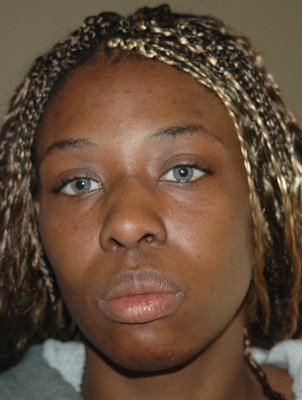 As noted above, the accuser alternately told the SANE (sexual assault nurse examiner), Tara Levicy, on March 14, 2006, that the extent of her imagined physical assault was being “grabbed” or “pinched, pushed and kicked in my butt.” In addition to those statements, the false one “continued to deny that she suffered physical blows by hands or that she was restrained or tied down in any way. She specifically denied being choked. She specifically denied that fists were used against her.” Despite those descriptions and contrary to Sgt. Gottlieb’s Grand Jury testimony, on March 16, 2006, Ms. Mangum told Sgt. Gottlieb and Investigator Benjamin Himan that she was choked or strangled. In between those two statements, she informed staffers at UNC Medical Center on March 15, 2006, that she had been knocked to the floor and hit her head on a sink. On April 3, 2006, she told physicians at UNC that her neck had been squeezed and kicked. In her written statement to police given on April 6, 2006, she contended that she was kicked in her “behind” and back before the assault, while also being hit in the face and kicked by both “Dan” and “Brett” and she omits any mention of being choked or strangled.
As noted above, the accuser alternately told the SANE (sexual assault nurse examiner), Tara Levicy, on March 14, 2006, that the extent of her imagined physical assault was being “grabbed” or “pinched, pushed and kicked in my butt.” In addition to those statements, the false one “continued to deny that she suffered physical blows by hands or that she was restrained or tied down in any way. She specifically denied being choked. She specifically denied that fists were used against her.” Despite those descriptions and contrary to Sgt. Gottlieb’s Grand Jury testimony, on March 16, 2006, Ms. Mangum told Sgt. Gottlieb and Investigator Benjamin Himan that she was choked or strangled. In between those two statements, she informed staffers at UNC Medical Center on March 15, 2006, that she had been knocked to the floor and hit her head on a sink. On April 3, 2006, she told physicians at UNC that her neck had been squeezed and kicked. In her written statement to police given on April 6, 2006, she contended that she was kicked in her “behind” and back before the assault, while also being hit in the face and kicked by both “Dan” and “Brett” and she omits any mention of being choked or strangled.“Three guys grabbed Nikki…Brett, Adam and Matt grabbed me. They separated us at the master bedroom door while we tried to hold on to each other. Brett, Adam and Matt took me into the bathroom.”Yet, Gottlieb falsely told the Grand Jury the accuser “never changed her story” from the SANE examination onward.
Yet, Gottlieb falsely told the Grand Jury the accuser “never changed her story” from the SANE examination onward.






